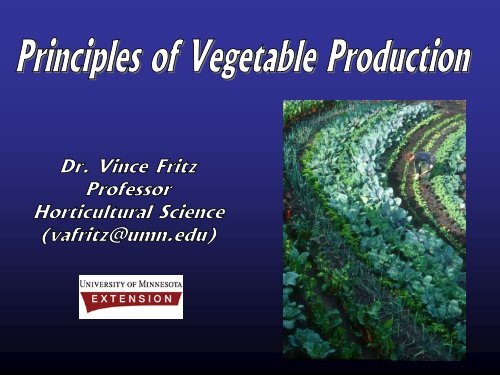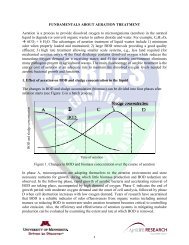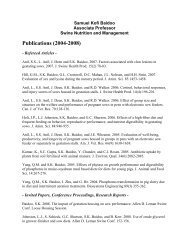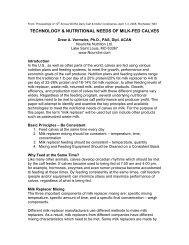Establish planting using transplants
Establish planting using transplants
Establish planting using transplants
You also want an ePaper? Increase the reach of your titles
YUMPU automatically turns print PDFs into web optimized ePapers that Google loves.
I got hooked<br />
on radishes and<br />
then got strung<br />
out on turnips!
‘I couldn’t<br />
stop - but it<br />
always seemed<br />
as if I was getting<br />
ahead!<br />
Take comfort<br />
In knowing<br />
there is help!
Perennial Crops<br />
Spring<br />
Crops<br />
Trellised Crops
Soil should be friable, well drained,<br />
and high in organic matter<br />
High clay content will cause problems<br />
with seedling emergence and drainage<br />
Compost, peat, and other soil<br />
amendments can improve garden<br />
performance<br />
Take a soil test!!
Try to buy only what you need<br />
Method of storage has a great impact on viability<br />
(ex. garage, basement, refrigerator)<br />
Conduct a germination test before<br />
<strong>planting</strong>
Genetic Types<br />
su - Normal sugary sweet creamy<br />
se - Sugary enhancer sweeter creamy<br />
sh2 - Supersweet<br />
sweetest crunchy
A general rule of thumb is<br />
that <strong>planting</strong> depth should<br />
be 4 -5 x the lateral width<br />
of the seed.<br />
Lateral width<br />
of seed
Too Shallow Too Deep<br />
Susceptible to desiccation Poor emergence<br />
Poor root development Delayed emergence<br />
Poor plant stature Susceptible to soil pathogens<br />
Influenced by mild soil Less competitive with weeds<br />
moisture fluctuations
Row <strong>planting</strong><br />
Equidistant or Broadcast<br />
<strong>planting</strong><br />
Hill <strong>planting</strong>
Prepare a furrow with a uniform depth<br />
Evenly distribute the seed<br />
Firm the soil over the furrow after <strong>planting</strong><br />
Water lightly, but thoroughly
Ensures the most efficient use of space<br />
Improves uniformity<br />
Enables the growing of long season<br />
vegetables<br />
Good fit for slow germinating vegetables<br />
Overcomes vernalization effects in some<br />
vegetables
Improves competitiveness with weeds<br />
Gives greater control in scheduling your harvest<br />
Avoid transplant shock – “harden” plants<br />
Transplant in evening or on a cloudy day<br />
Know which crops do not transplant well<br />
Avoid excessive wind
Annuals<br />
Most vegetable <strong>transplants</strong> are 3-4 weeks old<br />
Transplants should appear stocky (not spindly or leggy)<br />
Transplants should be free of any obvious disease and have<br />
a well developed root system but not root bound<br />
Dig a hole just large enough to accommodate the roots and<br />
plant slightly deeper than before<br />
(Caution! – danger of moisture wicking)
Perennials<br />
“Buyer beware” of mail order catalogues that sell varieties that<br />
do not do well in Minnesota<br />
Do some homework to familiarize yourself with the disease and<br />
insect problems of the crop<br />
Asparagus, one of the most common perennials in the home<br />
vegetable garden, are usually planted as 1-2 yr. old crowns<br />
Roots should appear healthy with good color
Check crowns for viable buds<br />
Until <strong>planting</strong>, store the crowns in a cool place and keep<br />
the roots moist but not wet<br />
Use good trans<strong>planting</strong> principles when placing them<br />
in your garden
Water thoroughly (1-2”/week)<br />
Water is the most essential to plant growth<br />
(nutrient uptake, root growth)<br />
Monitor regularly with a rain gauge
Crop<br />
Asparagus<br />
Broccoli / Cabbage<br />
Cauliflower<br />
Beans / Peas<br />
Carrot<br />
Sweet Corn<br />
Cucumber<br />
Eggplant / Tomato<br />
Lettuce<br />
Melons<br />
Stage of Development<br />
spear / fern growth<br />
head development<br />
head development<br />
pod filling<br />
emergence / growth<br />
silking / tasseling / ear growth<br />
flowering / fruit development<br />
flowering / fruit development<br />
emergence / head development<br />
flowering / fruit development
Isn’t This Just More Work??!<br />
Maximize yield<br />
Create the best plant environment<br />
Less labor requirements<br />
Raised Beds<br />
Basic Methods<br />
Inter<strong>planting</strong><br />
Vertical Gardening<br />
Succession or Relay Planting
Improves Soil Drainage<br />
Fast Spring Warm Up<br />
Reduces Compaction<br />
Easily Customize Special Planting
Mobile or permanent<br />
Usually 3-4 ft. wide<br />
Mix topsoil with composted manure and other<br />
amendments<br />
Final height of 8-12”<br />
Great for equidistant <strong>planting</strong> configurations
What is it?<br />
Use of trellises, nets, strings, cages, or poles to maximize<br />
crop growth and quality<br />
How to use it<br />
Vining crops are prime candidates (“space hogs”)<br />
(ex. melons, cucumbers, mini pumpkins)<br />
Monitor soil moisture closely<br />
Protection from excessive wind is really important
What is it?<br />
The growing of two or more vegetables in the same<br />
space at the same time<br />
Key relationships between different crops to consider<br />
Length of growing season<br />
Growth patterns<br />
Potential negative effects on growth<br />
Preferred season of production<br />
Light, nutrient, and moisture requirements
How to use it<br />
Accomplished by alternating rows, different plants within<br />
a row,or a randomized <strong>planting</strong><br />
Some Examples<br />
Carrots and Radishes<br />
Radishes and Broccoli<br />
Cabbage and Spinach<br />
How do these crops uniquely<br />
relate to each other?
What are they?<br />
Succession<br />
Planting of one crop in a space that was previously<br />
vacated by an earlier crop<br />
Relay<br />
Overlapping <strong>planting</strong>s of one crop<br />
Based on <strong>planting</strong> intervals<br />
Based on relative maturities (heat units)
Grow vegetables that:<br />
(Is Space Really Limiting?)<br />
Take up little space<br />
Bear fruit over a long period of time<br />
Have a dwarf type growth habit<br />
Light exposure on your deck or patio should be 8 – 10<br />
hours of direct sunlight<br />
Aluminum foil and other things can be used to direct more<br />
sunlight to the plant
Key points to remember:<br />
Protect plants from excessive heat, wind, and rain<br />
Be certain that pots and planter boxes are large<br />
Enough to provide adequate moisture for a couple<br />
of days
Why Use Them?<br />
Commonly used to harden off plants grown in a greenhouse<br />
Can also be used to produce cool season vegetable <strong>transplants</strong>
N<br />
lath or netting
Wood (no creosote or pentachlorophenol treated lumber)<br />
Strong sturdy sashes (plastic, glass, lexane)<br />
Simple system for draping lath or netting if needed
Does not require any outside energy source<br />
Underground heating cables significantly improves<br />
performance (Hot Bed)<br />
Locate in an area with good drainage<br />
Protect from excessive winds (personal experience)<br />
Provide ventilation if outside temperatures exceed 45 F
Dig out an area 8 - 9” deep<br />
Lay cable in 6 - 8” loops being careful not to cross over<br />
Cover with 2” of sand<br />
Lay down hardware cloth to protect from damage<br />
Cover with another 4 - 6” of soil
Key Benefits<br />
► trap solar radiation and soil moisture<br />
► lightweight and reusable<br />
► can ventilate during day<br />
► can heat during night<br />
► protect against insects (But…)
VS.<br />
Hoops required<br />
Removal is time critical<br />
Polyethylene<br />
(Slit vs. Perforated)<br />
Crop supported<br />
Raises with crop<br />
Spunbonded fabric
Application is crop dependent ! !<br />
VS.
Principally used to increase soil temperature and<br />
provide weed control<br />
Black plastic is the predominant material used in the U.S.<br />
Clear plastic is superior in soil warming capabilities however,<br />
herbicides are required for weed control<br />
Paper mulches continue to develop
RETRIEVABLE vs. DEGRADABLE<br />
High labor requirements Low labor requirements<br />
Reusable<br />
Disposable<br />
Special equipment needed No equipment needed<br />
Disposal problem<br />
Environment friendly<br />
Calibration concerns
Photodegradable<br />
Biodegradable<br />
UV light Microbe activity<br />
Unpredictable Slow process<br />
Crop dependent<br />
Residual degradation products<br />
Covered edges don’t degrade
IRT (Infrared Radiation Transmitting)<br />
SLT (Selective Light Transmission)<br />
Blocks solar radiation which promotes weed growth<br />
but allows infrared radiation to penetrate, warming<br />
the soil<br />
IRT / SLT mulches eliminate the need for chemical weed<br />
contrtol<br />
Color mulches change light quality in the plant canopy
Cucumbers on Green IRT Mulch
Watermelon on Green IRT Mulch
Peppers on Green IRT Mulch
Colored<br />
Black
Pr<br />
Red<br />
Far Red<br />
Pfr
How does phytochrome impact plant growth?<br />
FR / R<br />
FR /R
Tomatoes<br />
Potatoes<br />
Turnips
(Asparagus officinalis)<br />
•A perennial crop<br />
•Planted through either <strong>transplants</strong> or 1-2 yr. old<br />
crowns<br />
•Can continue to produce for 15yrs. and longer provided<br />
it is well cared for
•Choose a site with good drainage and full sun<br />
•Dig a trench 12-18” wide, trenches 4-5’ apart<br />
•Enrich top soil with composted manure, etc.<br />
•Refill trench with 2” of enriched top soil<br />
•Space crowns 18” apart with crown slightly<br />
elevated above the remaining root system
•Cover crowns with 2” soil<br />
•As plants grow, continue to add soil over the crowns<br />
(Why?)<br />
•Weed the <strong>planting</strong> in early spring to avoid damage<br />
to any emerging spears<br />
•Refrain from harvesting until the third year of production<br />
(Why?)
•In first year, harvest for only ~4 weeks (Why?)<br />
•Wait an additional year if <strong>transplants</strong> were used<br />
•Once 4yrs. old, the typical harvest lasts 6-8 weeks<br />
•Snap, don’t cut the spears just below the soil surface when<br />
they are 6-8” tall
•Promote excellent fern growth<br />
•Monitor for insect problems<br />
•Cut the fern down when it yellows, before the berries<br />
fall off, creating a “perennial” weed problem<br />
•Mulch with leaves, compost, etc.
Aphids<br />
Fusarium ‘Dieback’<br />
Asparagus Beetle
(Phaseolus vulgaris)<br />
•Bush snap bean is the most common garden type<br />
(green, wax, purple, etc.)<br />
•Romano types are very desirable to the home<br />
gardener<br />
•Other types of “beans” include scarlet runner<br />
and yard long beans
•After <strong>planting</strong>, avoid soil crusting<br />
•Keep maturing pods off of soil surface to avoid<br />
mold problems<br />
•Harvest before the “meat” between seeds becomes<br />
white and cottony in appearance
White Mold<br />
Bacterial Brown Spot<br />
Rhizoctonia<br />
Fusarium<br />
Pythium
(Brassica oleracea)<br />
(cabbage, broccoli, cauliflower, Brussels sprouts)<br />
•Cool season crops<br />
•Require timely nitrogen feedings for sustained growth<br />
•Rooting system is often shallow and fibrous<br />
•Sensitive to soil moisture fluctuations especially<br />
when plants are small
(Brassica oleracea var. italica)<br />
•Use of <strong>transplants</strong> is the best method to establish the <strong>planting</strong><br />
•Seedlings 3-4 weeks old are transplanted 18 and 30” apart,<br />
within and between rows, respectively<br />
•Due to the shallow and fibrous root system, extreme care<br />
should be taken when cultivating<br />
•Harvest the head before it begins to get loose and flower buds<br />
swell or turn yellow
(Brassica oleracea var. capitata)<br />
•Use <strong>transplants</strong> to establish <strong>planting</strong><br />
•Seedlings 3-4 weeks old are transplanted<br />
15-18” and 30” apart, within and between rows,<br />
respectively<br />
•Heads are harvested when they are firm<br />
Caution! - Watch out for cracking or splitting heads<br />
which occurs from excessive water uptake near maturity
(Brassica oleracea var.botrytis)<br />
•<strong>Establish</strong> through the use of <strong>transplants</strong><br />
•Space seedlings similar to other cole crops<br />
•Once curd formation has begun, blanching is necessary<br />
to produce the white curd<br />
•Some self-blanching varieties are available<br />
Caution! – Watch out for small curd formation<br />
called “buttoning” , brought on by stress
Downy Mildew<br />
Club Root<br />
Fusarium Yellows
Alternaria Spot<br />
Black Leg
Rhizoctonia (damping off)<br />
Sclerotinia (white mold/rot)
Diamondback Moth<br />
Imported Cabbage Worm<br />
Cabbage Looper
Cabbage Aphid<br />
Cabbage Maggot<br />
Flea Beetle
(Zea mays var. rugosa)<br />
•Three main genetic types<br />
•Isolation requirements are essential to maintain<br />
quality for some genetic types<br />
•Plant in multiple rows instead of single, long<br />
rows for better pollination<br />
•Some varieties do not do well in cold spring soils
•Isolation is critical to maintaining sweet corn quality<br />
(accomplished by space or time)<br />
•<strong>Establish</strong> by direct seeding<br />
•Plant seed in furrow 8-9” apart and in 30” rows<br />
•Can be transplanted<br />
•“Supersweet” varieties will not perform well if planted<br />
too early in the spring (soil temps.
•Maintain at least 250ft. between supersweet varieties<br />
from other sweet corn genotypes or field corn<br />
•About 3 weeks difference in projected harvest is also<br />
effective in preventing cross pollination<br />
•Ready to harvest at about 21 days after silking and tasseling<br />
(thumb nail test)<br />
•Protect quality by rapid cooling after harvest (Why?)
European Corn Borer<br />
Corn Earworm<br />
Aphids
Redwinged Blackbirds<br />
YUM!<br />
YUM!<br />
Raccoons
Common Smut<br />
Common Rust<br />
Caution! – Poor tip fill can be due to poor pollination brought on<br />
by silk clipping, <strong>planting</strong> too close, poor fertility, and weather<br />
Lodging
(Lycopersicon esculentum)<br />
•Most popular vegetable in the garden<br />
•Each plant can yield up to 15 lbs. of fruit<br />
•Types and sizes are endless and can be either<br />
determinate or indeterminate in growth pattern<br />
•Great for containerized gardening<br />
•Self pollinated (very efficient)<br />
•Spontaneous mutations have produced a variety<br />
of colors
•<strong>Establish</strong> <strong>planting</strong> <strong>using</strong> <strong>transplants</strong><br />
•Avoid producing spindly plants (What causes this?)<br />
•Harden off the <strong>transplants</strong> for about 2 weeks (How?)<br />
•Plants should be 6-7 weeks old when placed in the<br />
garden (after danger of frost)<br />
•Plant seedlings deep so they are well covered by the soil<br />
(roots will be produced along the buried stem)<br />
•With peat pot <strong>transplants</strong> – tear one side of the pot to<br />
encourage root growth
•Space staked or trellised plants 24” apart in rows<br />
3 ft. apart (reduces fruit rot)<br />
•Prune staked plants to 1 or 2 main stems<br />
•Remove other suckers<br />
•Cages also work well<br />
•Ventilation between plants is important (Why?)<br />
•Harvest when vine-ripe and before cracking<br />
•Leave pedicel on fruit (Why?)
Verticillium<br />
Early Blight<br />
Late Blight
Bacterial Spot<br />
Fusarium Wilt<br />
Bacterial Speck<br />
Tobacco Masaic Virus
Aphids<br />
Whiteflies<br />
Colorado Potato<br />
Beetle<br />
Flea Beetle<br />
Hornworm
Blossom End Rot<br />
Sunscald<br />
Walnut Wilt<br />
Fruit Cracking
(Solanum tuberosum)<br />
•White, yellow, red, and purple varieties<br />
•Russets, white, and yellow flesh<br />
•Grow for either a new crop or a full season<br />
storage crop<br />
•Vegetatively grown<br />
•Stores well
•<strong>Establish</strong> <strong>planting</strong> with seed pieces (2 oz.)<br />
•Use only certified seed (Why?)<br />
•Seed potatoes should be firm and not yet<br />
sprouted and have at least 1 eye<br />
•Plant in furrows cut side down, 3-5” deep 8-9”<br />
apart in rows spaced ~36” apart<br />
•Build soil around plants as you cultivate<br />
to protect future tubers from sun exposure
•Harvest when most tubers have reached<br />
2” in diameter<br />
•Remove the vines and allow to set 1-2 weeks<br />
for skin set to be completed (bruising will<br />
also be reduced)<br />
•After harvest, heal (suberize) potatoes by<br />
storing at a minimum of 50ºF for 2-3 weeks<br />
•Afterwards, store at 40ºF
Cautions!<br />
•Green skin is due to sun exposure<br />
•Hollow heart is due to soil moisture fluctuations<br />
•Black walnut wilt
Colorado Potato<br />
Beetle<br />
Leafhoppers<br />
Late Blight<br />
Early Blight<br />
Soft Rot<br />
Viruses<br />
Flea Beetle<br />
Wilts
(Solanum melongena)<br />
•Warm season vegetable<br />
•Many types<br />
•Prime candidate for plastic mulch and<br />
row covers<br />
Caution! – Poor fruit set is due to high temperatures during<br />
flowering and dry conditions
•<strong>Establish</strong> <strong>planting</strong> <strong>using</strong> <strong>transplants</strong><br />
•Seedlings should be 8-10 weeks old<br />
•Effective hardening of the plants is crucial<br />
•Plant 15-18” apart in 30” rows<br />
•Pinch main growing point when 6-8” tall<br />
to encourage branching (if not trellised)<br />
•Harvest when fruit is 8-9” long and glossy
(Capsicum annuum)<br />
•Endless number of types and colors<br />
•Warm season crop<br />
•Effective “hardening” period is crucial in establishment<br />
•Very slow seed germination rate
•<strong>Establish</strong> <strong>planting</strong> <strong>using</strong> <strong>transplants</strong><br />
•Seedlings should be 7-8 weeks old<br />
•Plant 15-18” apart within the rows spaced 30” apart<br />
•Production could be enhance with plastic mulch and<br />
row cover systems<br />
•Harvest as either immature or mature fruit<br />
Caution! – Blossom end rot can be due to soil moisture<br />
fluctuations, high night temperatures, and excessive fruit set
(Cucumis melo)<br />
•Warm season crop<br />
•Muskmelon, cantaloupe, watermelon,<br />
honeydew, etc.<br />
•Monoecious flowering habit<br />
•Requires “pollinators” for effective fruit set
•<strong>Establish</strong> <strong>planting</strong> <strong>using</strong> <strong>transplants</strong><br />
•Transplants 2-3 seedlings into hills spaced 2-3 feet<br />
apart in rows 5 feet apart<br />
•Yield potential is improved on plastic mulch and<br />
fruit remain clean<br />
•Can be trellised but each fruit should be supported<br />
•Keep the belly of the fruit from becoming wet for<br />
extended periods (boards, plastic, trellising, straw, etc.)
•Fruit quality is maximized at “full slip”<br />
•After harvest, plunge the fruit into<br />
cold water and store at 40ºF from<br />
4-10 days
Fusarium Wilt<br />
Powdery Mildew<br />
Downy Mildew<br />
Remove from<br />
Garden!<br />
Bacterial Wilt and the Spotted<br />
and Striped Cucumber Beetles<br />
Alternaria Leaf Spot<br />
Angular Leaf Spot
Flea Beetles<br />
Cucumber Beetles<br />
Vine Borer<br />
Squash Bug
(Allium cepa)<br />
•Yellow, white, and red colors<br />
•Pungent and sweet types, green onions<br />
•Bulbing is initiated by daylength<br />
•Shallow rooted<br />
•Candidate for raised beds and broadcast<br />
seeding
•<strong>Establish</strong> <strong>planting</strong> by direct seeding ,<br />
the use of sets, or <strong>transplants</strong><br />
•Plant 12 seeds per foot in rows spaced<br />
12-14” apart<br />
•Protect from ‘blow out’ (What is this?)<br />
•Plant sets 1-2” apart in rows 1-2” deep<br />
•Planting sets too early in the spring will<br />
cause bolting to occur
•Use only ‘long day’ varieties!<br />
•Harvest when 2/3 of the tops have fallen<br />
•‘Curing’ is essential to long term quality<br />
storage (What is this?)<br />
•Sweet varieties do not store as well as<br />
pungent varieties<br />
Caution! – Split or double bulbing is due to dry conditions<br />
Small bulbs are due to <strong>planting</strong> too close or too late
Alternaria Purple Blotch<br />
Botrytis<br />
Onion Maggot<br />
Smut<br />
Thrips
(Cucurbita sp.)<br />
•Warm season vegetable crops<br />
•‘Winter’ varieties and types are numerous<br />
•Many ‘summer’ varieties and types<br />
•Monoecious flowering habit<br />
•Requires pollinators
•<strong>Establish</strong> <strong>planting</strong> <strong>using</strong> <strong>transplants</strong><br />
•Seedling age should be 3-4 weeks old<br />
•Older seedlings that are hardened off<br />
will not transplant well and growth will slow<br />
•Plastic mulches are commonly used<br />
•Plant in a area sheltered from wind<br />
•Squash store easily in cool areas / protect<br />
from frost
•Flower drop due to heavy fruit set (or male flowers)<br />
•Blossom end rot due to soil moisture fluctuations
(Cucumis sativus)<br />
•Warm season vegetable<br />
•Monoecious flowering habit<br />
•Slicers and picklers<br />
•Parthenocarpic and gynoecious varieties<br />
•Performs well on plastic mulch<br />
•Sandy soils work very well<br />
•Spreading plant growth habit however<br />
some bush types are available
•<strong>Establish</strong> <strong>planting</strong> by direct seeding<br />
•Plant seeds and later thin to 9-12” apart when<br />
seedlings are 5” tall<br />
•If trellised, plant 4-5 seeds per foot in rows<br />
spaced 30” apart<br />
•Responds well to plastic mulch systems<br />
•Due to “apical dominance”, multiple harvests<br />
maximize yield potential (What is this?)
•Misshapen fruit due to low fertility, poor<br />
pollination, and big fluctuations in temperature
(Lactuca sativa)<br />
•Cool season crop<br />
•Many types (bibb, romaine, leaf, etc.)<br />
•Easy to grow<br />
•Bolts in high temperatures<br />
•Head types are difficult to grow due to<br />
heat stress<br />
•Practice succession <strong>planting</strong> for continued<br />
harvest
•<strong>Establish</strong> through direct seeding (can transplant)<br />
•Plant 10-20 seeds per foot in rows spaced 8-12”<br />
apart, later, thin seedlings to 4-8” apart<br />
•Candidate for raised beds and broadcast seeding<br />
•Use frequent and light waterings<br />
•Use other crops to shade during heat of the day<br />
Caution! – Tip burn is due to variation in<br />
soil moisture, onset of bolting, and high<br />
temperatures
Anthracnose<br />
Aphids<br />
Sclerotinia<br />
Botrytis (Gray Mold)<br />
Stem and Leaf Rots
Cole Slaw Anyone??






